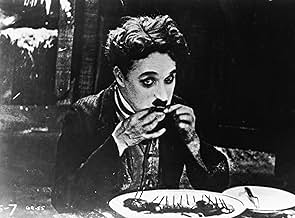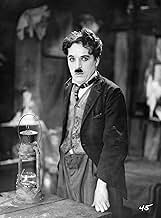- Candidato a 2 Oscar
- 7 vittorie e 3 candidature totali
Jack Adams
- Man in Dance Hall
- (non citato nei titoli originali)
Frank Aderias
- Eskimo Child
- (non citato nei titoli originali)
Leona Aderias
- Eskimo Child
- (non citato nei titoli originali)
Lillian Adrian
- Woman in Dance Hall
- (non citato nei titoli originali)
Sam Allen
- Man in Dance Hall
- (non citato nei titoli originali)
Claude Anderson
- Man in Dance Hall
- (non citato nei titoli originali)
Harry Arras
- Man in Dance Hall
- (non citato nei titoli originali)
Albert Austin
- Prospector
- (non citato nei titoli originali)
F.J. Beauregard
- Man in Dance Hall
- (non citato nei titoli originali)
Marta Belfort
- Woman in Dance Hall
- (non citato nei titoli originali)
William Bell
- Man in Dance Hall
- (non citato nei titoli originali)
Francis Bernhardt
- Man in Dance Hall
- (non citato nei titoli originali)
Riepilogo
Reviewers say 'The Gold Rush' is acclaimed for its comedy, visual storytelling, and iconic scenes. Charlie Chaplin's Little Tramp is lauded for humor and emotional depth. The film blends slapstick with themes of loneliness and resilience, resonating deeply. Its historical significance in silent cinema and influence on filmmakers are noted. The 1942 re-release with narration and music is appreciated, though some favor the original. It remains a timeless masterpiece.
Recensioni in evidenza
Charlie Chaplin is the Lone Prospector who goes to Klondike, Alaska in search of gold.There he meets and falls in love to beautiful Georgia (Georgia Hale).In cold and snowy Alaska he rambles forward looking for gold with his fellow prospector Big Jim McKay (Mack Swain) thinking of her.A genius called Charlie Chaplin made in 1925 this silent movie masterpiece known as The Gold Rush.Now nearly 80 years after the film was made we get to watch this genius in a tramp suit doing his job.And he did it well.Better than probably anybody.He could make us laugh and he could make us cry.Maybe even both of those at the same time.Chaplin realized that every good comedy has a little tragedy. Of course I have to give credits to other actors as well.Mack Swain as Big Jim McKay is not only a big man, he's also big at his acting skills. Georgia Hale is as beautiful of woman as she is a great actress. The Gold Rush is filled with marvelous scenes.The most memorable is the shoe-eating scene.Chaplin on the dance floor is also something to remember.Through the movie you can hear the score Chaplin composed to this movie.It works perfectly.Just like the whole movie.It's pure gold from the beginning till the end.
One of the great Chaplin movies is 'The Gold Rush' and although it is not his best it contains one of the best known Chaplin-sequences. The sequence with the dancing rolls is one of the best I have seen in any Chaplin, whether it is a feature film or a two-reeler. For me this alone makes 'The Gold Rush' worth watching.
There are other great moments in this story where Chaplin is the Lone Prospector who falls in love with a girl named Georgia (Georgia Hale). When Chaplin has to find some gold (the movie isn't name 'The Gold Rush' for nothing) together with Hank (Henry Bergman) they stay in a cottage in the mountains. The sequence with this cottage after a blizzard is another that belongs to the greatest sequences in a Chaplin movie.
Of course we know from the start how things will end with the girl and the gold but the way that leads to that point is a nice one. Personally I think it is not great all the time, some sequences make it great, and sometimes even a little too simple. Because of the sequences described above (and some others) and because of the artist that Chaplin is this still belongs to the better silent movies I have seen.
There are other great moments in this story where Chaplin is the Lone Prospector who falls in love with a girl named Georgia (Georgia Hale). When Chaplin has to find some gold (the movie isn't name 'The Gold Rush' for nothing) together with Hank (Henry Bergman) they stay in a cottage in the mountains. The sequence with this cottage after a blizzard is another that belongs to the greatest sequences in a Chaplin movie.
Of course we know from the start how things will end with the girl and the gold but the way that leads to that point is a nice one. Personally I think it is not great all the time, some sequences make it great, and sometimes even a little too simple. Because of the sequences described above (and some others) and because of the artist that Chaplin is this still belongs to the better silent movies I have seen.
Charles Chaplin's "The Gold Rush" is arguably his finest film. He stars as a wimpy prospector who decides to go to the Klondike in the hopes of striking it rich. What he does not realize is that he may find love (in the form of Georgia Hale) instead of money. In the end that may be all right with him. "The Gold Rush" shows everything that made Charles Chaplin the great performer, writer and director he was. Quite possibly the finest cinematic icon of the 20th Century, Chaplin showed humanity, love and an undying want to entertain all audiences throughout his stellar cinematic career. The movie is exceptional in every way. Although I am not as well-versed with movies from the 1920s as I am with the decades following it, I would still probably call "The Gold Rush" the finest film of that 10-year period. Oh how the cinema misses Charles Chaplin today. 5 stars out of 5.
This silent classic has many strong points - it has a lot of humor, interesting characters, a good story and good settings. It's the kind of film that shows how much a master film-maker can communicate in a silent movie. It overdoes the sentimentality on occasion, but other than that it's a fine film.
Chaplin himself plays the 'Lone Prospector', and he is joined by several other interesting characters in a frozen north setting that sets up some good adventures and drama. There are some memorable scenes in the prospectors' rickety cabins, plus some other good material.
The version of this that is the easiest to find is the one that Chaplin re-edited in the 1940's, adding his own narration and deleting the title cards, which gives it a slightly different feel. (These revisions probably make it a bit easier to follow for those who aren't used to silent films.) You can tell from Chaplin's narration how fond he must have been of "The Gold Rush", and he had a lot of good reasons to be pleased with it. There are a couple of his later films that might be even better and more timeless, but this one contains everything that defined Chaplin and his art.
Chaplin himself plays the 'Lone Prospector', and he is joined by several other interesting characters in a frozen north setting that sets up some good adventures and drama. There are some memorable scenes in the prospectors' rickety cabins, plus some other good material.
The version of this that is the easiest to find is the one that Chaplin re-edited in the 1940's, adding his own narration and deleting the title cards, which gives it a slightly different feel. (These revisions probably make it a bit easier to follow for those who aren't used to silent films.) You can tell from Chaplin's narration how fond he must have been of "The Gold Rush", and he had a lot of good reasons to be pleased with it. There are a couple of his later films that might be even better and more timeless, but this one contains everything that defined Chaplin and his art.
I'm just an 18 year old dude in high school that was assigned this movie in a class at my school. When I first saw the genres of this movie I was not looking forward to it at all. It was the first silent movie I was seeing and also the oldest. It had originally seemed like everything I didn't look for in a "good" movie. At the conclusion of this movie I knew that my original thought process was entirely wrong. This movie has certainly changed my view on both silent and older films, especially on a comedic standpoint. There was so much about it that was appealing to the viewer. I recommend this movie to all looking to expand their film genres of interest.
Lo sapevi?
- QuizSir Charles Chaplin stated that this was the film by which he most wanted to be remembered.
- BlooperWhen Big Jim is delirious and thinks The Lone Prospector is a chicken, The Lone Prospector removes a knife from the table and hides it in the bed. In one of the next shots, the knife is back on the table. Then in the next shot, it is gone again.
- Versioni alternativeThere is a 1942 re-issue version, prepared by Charles Chaplin himself, which uses his own narration, music score, and editing (running time: 72 minutes). This version is the only one which has its copyright owned by the Chaplin Film company. Many scenes of the 1942 version derived from an alternate camera that was shooting simultaneously. This explains some of the very slight differences in camera angle, although Chaplin also deleted some footage in order to tighten the pacing (such as Big Jim and the Tramp's near-encounter in the Gold Rush town and the shot of a woman comforting another woman during the singing of "Auld Lang Syne".
- ConnessioniEdited into Werner Herzog Eats His Shoe (1980)
I più visti
Accedi per valutare e creare un elenco di titoli salvati per ottenere consigli personalizzati
- How long is The Gold Rush?Powered by Alexa
Dettagli
- Data di uscita
- Paese di origine
- Siti ufficiali
- Lingue
- Celebre anche come
- The Gold Rush
- Luoghi delle riprese
- Azienda produttrice
- Vedi altri crediti dell’azienda su IMDbPro
Botteghino
- Budget
- 923.000 USD (previsto)
- Lordo in tutto il mondo
- 79.350 USD
- Tempo di esecuzione
- 1h 35min(95 min)
- Colore
- Mix di suoni
- Silent(original release)
- Proporzioni
- 1.33 : 1
Contribuisci a questa pagina
Suggerisci una modifica o aggiungi i contenuti mancanti




























